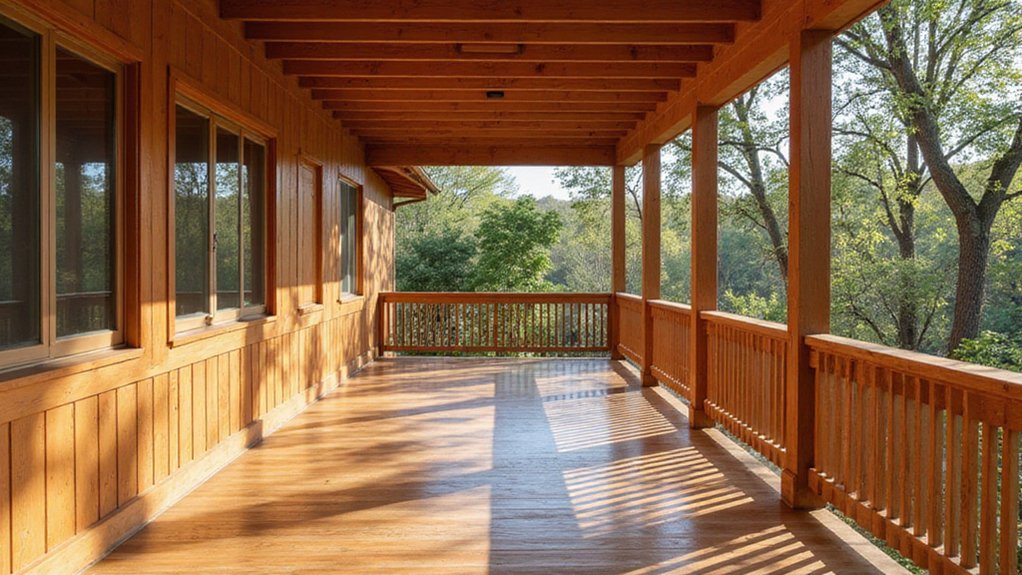As you stand on your covered porch, you’re faced with a pivotal decision: to paint or to stain. The choice isn’t just about aesthetics; it’s about durability, maintenance, and the overall longevity of your porch’s finish. You’ll need to consider the purpose of your porch, the type of wood it’s made of, and the climate you live in. With so many factors at play, it is imperative to weigh the pros and cons of each option carefully. So, where do you start?
Understanding the Purpose of Your Porch
Because your porch is an extension of your living space, it’s essential to determine how you plan to use it before deciding between painting and staining.
You’ll want to think about the activities you’ll be doing on your porch, such as dining, lounging, or entertaining. Consider the number of people who’ll be using the space and any accessibility requirements you need to meet.
Will you need to accommodate wheelchairs or strollers? Do you plan to add outdoor furniture or decorations that might impact the flooring? Defining your intended usage will help you decide which finish is best suited for your porch.
For example, if you’ll be using your porch frequently, you may want a finish that’s easy to clean and maintain. By understanding the purpose of your porch, you’ll be able to make an informed decision about whether to paint or stain it.
Additionally, consider that a well-chosen finish can provide protection from elements and extend the lifespan of your porch flooring.
Durability and Maintenance Considerations
Now that you’ve determined how you’ll use your porch, it’s time to ponder the durability and maintenance needs of your flooring. You’ll want to contemplate the weathering resistance of both painting and staining to guarantee your porch can withstand the elements.
Painted surfaces tend to be more prone to peeling and chipping, especially in high-traffic areas, whereas stained surfaces often provide better protection against moisture and UV damage. When it comes to upkeep requirements, painting typically needs more frequent touch-ups, as it’s more susceptible to fading and scratches. Staining, on the other hand, can last longer between applications, but may require more labor-intensive prep work. Additionally, for comprehensive protection and beauty, consider professional services that offer high-quality finishes for porch exterior painting projects.
Aesthetics and Color Options
Your porch’s aesthetic appeal is largely influenced by the finish you choose, so it’s vital to evaluate the variety of color options and visual effects that painting and staining offer. When it comes to aesthetics, both painting and staining provide a wide range of possibilities.
- Color Options: Paint offers a vast array of colors, allowing you to match or contrast with your home’s exterior. Stain, on the other hand, enhances the natural beauty of the wood while providing a more understated color palette.
- Texture Options: Painting provides a smooth, uniform finish, while staining can accentuate the natural texture of the wood, adding depth and character to your porch.
- Design Inspiration: Both painting and staining can be used to create a unique design inspiration for your porch, from rustic to modern, depending on the color and style you choose.
Wood Type and Condition
The type of wood you’re working with massively impacts the decision to paint or stain your covered porch. Different wood types respond uniquely to finishes, and understanding their characteristics is fundamental.
For instance, woods with intricate wood grain patterns, like oak or pine, may benefit from staining to accentuate their natural beauty. On the other hand, woods with less distinct patterns, like fir or spruce, might be better suited for painting.
Additionally, the condition of your wood also plays a significant role. If your wood has signs of wear, cracks, or damage, staining mightn’t be the best option, as it could exacerbate the issues and compromise the structural integrity of your porch. You’ll need to assess the wood’s condition and choose the finish that best addresses its specific needs.
Climate and Weather Resistance
Exposed to the elements, your covered porch is vulnerable to climate and weather conditions that can drastically impact its durability and appearance. Sun exposure, moisture management, and extreme temperatures can all take a toll on your porch.
To safeguard your porch’s longevity, consider the following factors when deciding between painting and staining:
- UV resistance: Will your chosen finish protect your porch from harsh sun exposure, or will it fade and degrade over time?
- Moisture management: How well will your finish handle rain, snow, and humidity, and can it prevent water damage and rot?
- Temperature fluctuations: Can your finish withstand extreme heat and cold, or will it crack and peel with seasonal changes?
Budget and Cost Factors
When it comes to deciding between painting and staining your covered porch, one pivotal factor to contemplate is the expense. You’ll want to evaluate the upfront costs of materials, labor, and potential financing options. A cost analysis will help you ascertain which option is more budget-friendly.
Generally, staining is less expensive than painting, as it requires fewer coats and less prep work. However, high-quality stains can still be costly. Painting, on the other hand, may require more materials and labor, but it can also provide a more dramatic transformation.
Be sure to factor in the cost of any necessary repairs or maintenance to your porch’s structure before applying either a stain or paint. By weighing these cost factors, you can make an informed decision that fits your budget and meets your needs.
Personal Preference and Lifestyle
Three key aspects of your personal preference and lifestyle should influence your decision between painting and staining your covered porch: aesthetic appeal, maintenance requirements, and functional needs.
- Aesthetic appeal: Think about the style and atmosphere you want to create on your porch. Do you prefer a bold, radiant color or a more subtle, natural look?
- Maintenance requirements: Consider how much time and effort you’re willing to dedicate to upkeep. Staining typically requires more frequent touch-ups than painting.
- Functional needs: Reflect on how you plan to use your porch. If you’ll be using it frequently, especially during certain seasons, you may prioritize personal comfort and durability.
Your personal comfort and seasonal usage patterns should also factor into your decision. If you’ll be using your porch extensively during the summer, you may want a finish that can withstand heavy traffic and harsh sunlight. By considering these factors, you can make an informed decision that aligns with your lifestyle and preferences.
Frequently Asked Questions
Can I Mix Painting and Staining on the Same Porch?
You can mix painting and staining on the same porch to create blended finishes, achieving a customized appearance that reflects your personal style, but guarantee a cohesive look by choosing complementary colors and finishes that harmonize with your outdoor space.
How Do I Fix Mistakes After the Paint or Stain Is Applied?
When fixing mistakes, you’ll need to sand improperly applied paint or scrape off failed stain. Then, clean the surface and reprime before repainting over the corrected area, ensuring a smooth, even finish that blends seamlessly with the rest of your porch.
Will Painting or Staining Hide Imperfections in the Wood?
When you’re trying to hide imperfections in the wood, you’ll find that both paint and stain can be effective. Stain, in particular, fills minor cracks and covers uneven grain, while paint provides a thicker, more opaque coverage that can mask more significant flaws.
Can I Use a Roller to Apply Paint or Stain to the Porch?
When applying paint or stain, you’ll get better results using an edger tool for corners and edges, then switching to a roller for larger areas, working in sections to maintain even coverage and avoid streaks.
Do I Need to Prime the Wood Before Painting or Staining?
You’ll need to prime the wood if it’s a softwood or has imperfections, but if it’s a hardwood, you might get away without priming, depending on the wood type and prep work required to guarantee a smooth, even finish.

